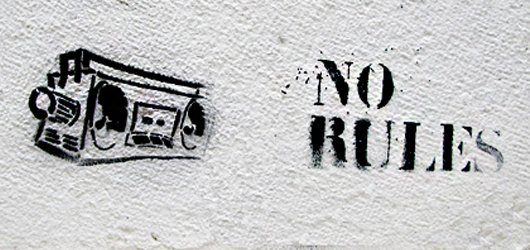
I recently started co-teaching 12 week class on User Experience Design in partnership with General Assembly. One of the most common questions the students ask is for concrete Best Practices about UXD. It’s been really challenging to try and identify Best Practices, simply because of the breadth of content we’re covering. So, this got me thinking, do Best Practices exist and does the idea of them distract us from more valuable learnings?
The idea of Best Practices implies that if you do a set thing, a set result will occur. It makes us believe that there is a rulebook for how to successfully design an experience. In reality, I’ve never been one to follow the rules, maybe it’s why I love designing experiences so much.
I think we need to do everything we can to try and shift the impression that there are “rules” for how to do what we do. Because the truth is, and we all know it, there is no one way to do what we do. So much of what we do is about problem and solve, about try and try again, about incrementally moving forward. We ultimately design for people, and people are different. People think different, feel different, and behave different. So thinking that applying a set rule to an experience will yield the same result from people is not possible.
So, instead of thinking about rules, I think we should focus on patterns and guidelines, common ways of thinking that provide us with a default, a starting point that we can then tailor to the unique product and the people we’re designing for.
I recently found this TED Talk by Andrew Stanton (animator, writer, and director at Pixar) called The Clues To A Great Story. In the talk he recounts the process of writing Toy Story. The writing process wasn’t going so well and someone suggested they apply the common elements that had made other animated films successful (villain, love story, happy songs, etc). The team chose to not follow these “rules” and thank goodness the did! Andrew speaks about how that experience made him realize that “Storytelling has guidelines, not hard fast rules”.
I think the same concept applies to User Experience Design. There are patterns and guidelines that can help us get started. But ultimately, a great experience comes from understanding people and tailoring the experience to their needs. So back to my original though on educating people about UXD, I think our focus should be less on methods and mechanics, and more on training people how to think – how to be curious and observant, how to develop ethos, how to tell stories, and how to solve problems.
What are you thoughts? Are education programs in UXD focused too much on mechanics? Do Best Practices give us (or clients) a false sense of future success? What can we do to help people design beyond the defaults to create great experiences?
Photo credit: biphop from Flickr